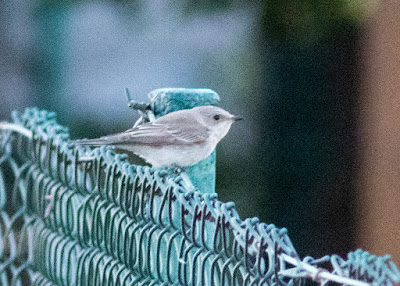Nightjars are one of my favourite birds. They are extremely rare in Ireland, but I'm lucky to have fond memories of a churring male as well as sightings of a female at an upland site in Tipperary some decade ago. On hindsight, this night is one of my all-time birding highlights. It was just magical - topped off with a supporting cast of roding Woodcock, reeling Grasshopper Warblers and the iconic song of the Common Cuckoo.
Living in Catalunya, now; I have ample opportunity to see and hear two species; Red-necked Nightjar and European Nightjar. It comes as no surprise that I am a keen Delta del Llobregat birder, and when a friend told me of a second-hand report of a singing Red-necked Nightjar, in the delta I was very interested. We drove to the spot one night and found ourselves in a sandy car-park by the sea, which skirted a lovely coastal pinewood. It looked nice. We weren't sure if we would see or hear anything but were ever-hopeful as it was a delta tick for us.
In the vicinity of the car park we had some migrants and found a lovely Balearic Flycatcher Muscicapa tyrrhenica balearica, with a nice Whinchat.
We walked along the coastal track with our ears pointed
to the woodland and eventually we detected a distant Red-necked
Nightjar! We waited a while and realised the sound seemed to be coming
from the direction of the car, so we headed back to try to hear it
better. Upon returning we realised it was literally singing its heart
out just feet from the car. We listened in pure amazement and even saw
it displaying several times. We enjoyed the bird for a good 20 minutes,
before heading home, taking a route through the agricultural zone of Can
Dimoni.
This is where the catch comes in. As I drove back I had the windows rolled in case we heard an owl, a late singing Quail or another Nightjar. Then suddenly I stopped in excitement, listening to what I thought was a European Nightjar! Still on a high from the Red-necked I drove closer to the sound and took a recording. It had been at least a decade since I had heard a European Nightjar, but in the heat of the moment my memory told me that this was one. Fantastic. It even had the sudden pitch changes which I could vaguely remember the Irish bird doing that time back.
A little later, having sent the recording to my good friend Harry Hussey, as sharp as ever, he expressed some concern and said it didn't sound quite right. Furthermore, I was told about an insect that can sound similar to European Nightjar. I googled it and listened to a recording and my heart sank. This was it! European Mole Cricket Gryllotalpa gryllotalpa! Wow. They really do sound quite like a Nightjar, and are thought to be the loudest insect on the planet (they are surprisingly loud).
For someone who comes from a country where there really aren't any audible nocturnal insects, and certainly not at this volume, I think this could catch you out, at least momentarily. When you listen to both species online, side by side there is a noticeable difference, and in fact the similarities are only superficial, but in the field it really tricked me.
In actuality the tone and rhythm are quite different between the two species, and the sudden change in pitch is represented as a slight momentary rise in Mole Crickets (see fig.1), with a slight drop in pitch in European Nightjar (see 2nd recording: XC326855). It won't happen to me again but it's good to know that this insect exists and can make sounds like that! Lesson learned.
In actuality the tone and rhythm are quite different between the two species, and the sudden change in pitch is represented as a slight momentary rise in Mole Crickets (see fig.1), with a slight drop in pitch in European Nightjar (see 2nd recording: XC326855). It won't happen to me again but it's good to know that this insect exists and can make sounds like that! Lesson learned.
 |
| Figure 1. European Mole Cricket, with a slight, momentary increase in pitch at approx' 2.5s. |
To compare, here is a recording taken in the UK of an actual European Nightjar. You can clearly see the momentary drop in pitch, about halfway through the file. This contrasts to the rise in pitch seen in the European Mole Cricket, above, in figure 1.









































































